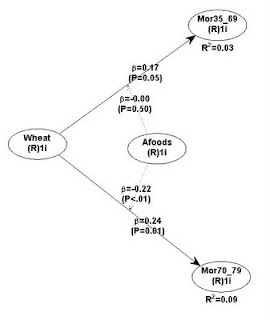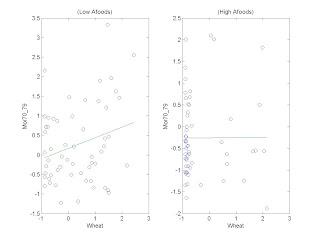In previous posts on this blog covering the China Study II data we’ve looked at the competing effects of various foods, including wheat and animal foods. Unfortunately we have had to stick to the broad group categories available from the specific data subset used; e.g., animal foods, instead of categories of animal foods such as dairy, seafood, and beef. This is still a problem, until I can find the time to get more of the China Study II data in a format that can be reliably used for multivariate analyses.
What we haven’t done yet, however, is to look at moderating effects. And that is something we can do now. A moderating effect is the effect of a variable on the effect of another variable on a third. Sounds complicated, but WarpPLS makes it very easy to test moderating effects. All you have to do is to make a variable (e.g., animal food intake) point at a direct link (e.g., between wheat flour intake and mortality). The moderating effect is shown on the graph as a dashed arrow going from a variable to a link between two variables.
The graph below shows the results of an analysis where animal food intake (Afoods) is hypothesized to moderate the effects of wheat flour intake (Wheat) on mortality in the 35 to 69 age range (Mor35_69) and mortality in the 70 to 79 age range (Mor70_79). A basic linear algorithm was used, whereby standardized partial regression coefficients, both moderating and direct, are calculated based on the equations of best-fitting lines.
From the graph above we can tell that wheat flour intake increases mortality significantly in both age ranges; in the 35 to 69 age range (beta=0.17, P=0.05), and in the 70 to 79 age range (beta=0.24, P=0.01). This is a finding that we have seen before on previous posts, and that has been one of the main findings of Denise Minger’s analysis of the China Study data. Denise and I used different data subsets and analysis methods, and reached essentially the same results.
But here is what is interesting about the moderating effects analysis results summarized on the graph above. They suggest that animal food intake significantly reduces the negative effect of wheat flour consumption on mortality in the 70 to 79 age range (beta=-0.22, P<0.01). This is a relatively strong moderating effect. The moderating effect of animal food intake is not significant for the 35 to 69 age range (beta=-0.00, P=0.50); the beta here is negative but very low, suggesting a very weak protective effect.
Below are two standardized plots showing the relationships between wheat flour intake and mortality in the 70 to 79 age range when animal food intake is low (left plot) and high (right plot). As you can see, the best-fitting line is flat on the right plot, meaning that wheat flour intake has no effect on mortality in the 70 to 79 age range when animal food intake is high. When animal food intake is low (left plot), the effect of wheat flour intake on mortality in this range is significant; its strength is indicated by the upward slope of the best-fitting line.
What these results seem to be telling us is that wheat flour consumption contributes to early death for several people, perhaps those who are most sensitive or intolerant to wheat. These people are represented in the variable measuring mortality in the 35 to 69 age range, and not in the 70 to 79 age range, since they died before reaching the age of 70.
Those in the 70 to 79 age range may be the least sensitive ones, and for whom animal food intake seems to be protective. But only if animal food intake is above a certain level. This is not a ringing endorsement of wheat, but certainly helps explain wheat consumption in long-living groups around the world, including the French.
How much animal food does it take for the protective effect to be observed? In the China Study II sample, it is about 221 g/day or more. That is approximately the intake level above which the relationship between wheat flour intake and mortality in the 70 to 79 age range becomes statistically indistinguishable from zero. That is a little less than ½ lb, or 7.9 oz, of animal food intake per day.

